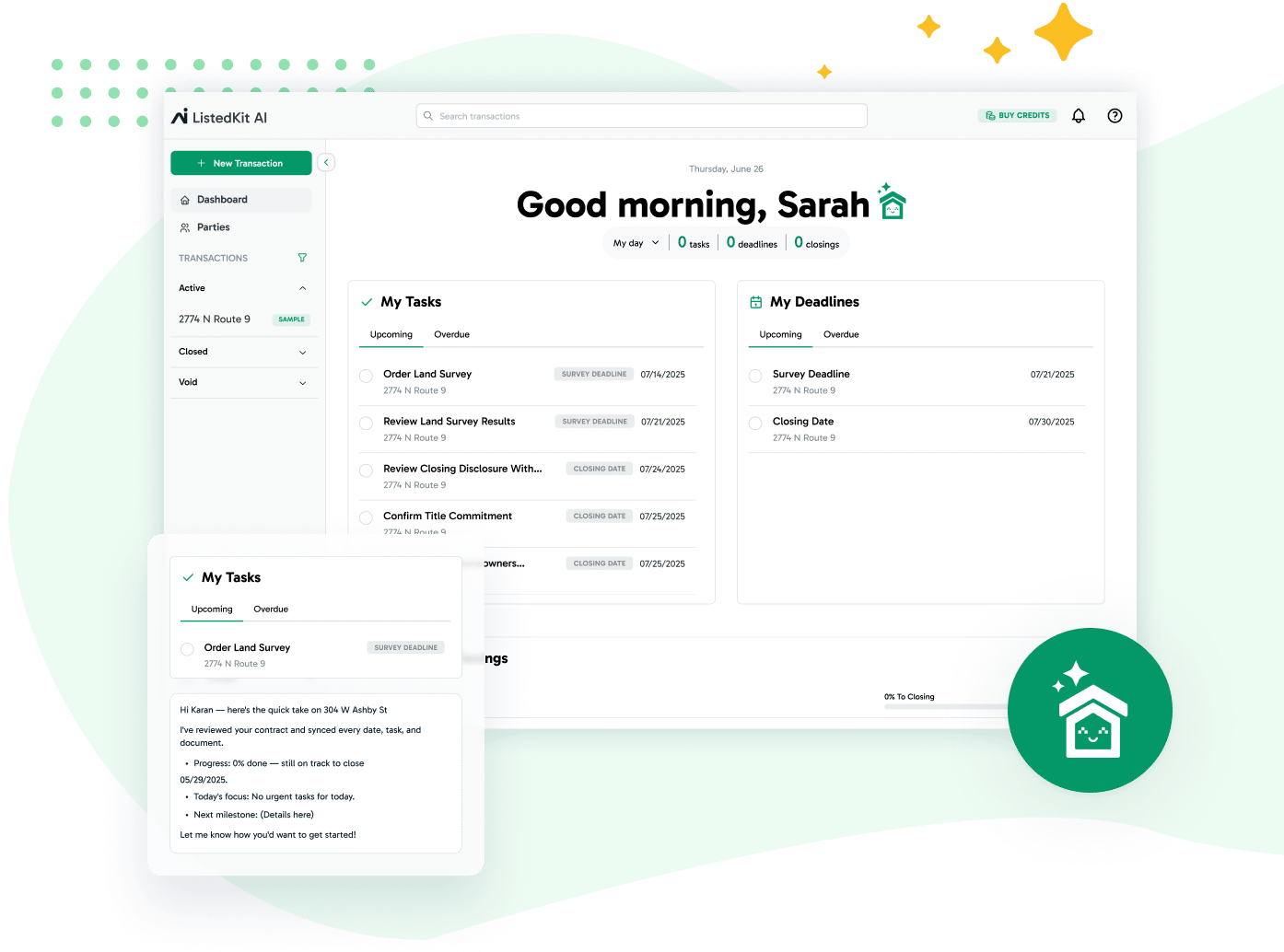Most real estate agents rely on the MLS to find listings, but the most lucrative opportunities often exist beyond standard searches. Agents who use real estate data analytics gain deeper insights into market trends, identify undervalued properties, and anticipate shifts in demand before their competitors.
Traditional methods limit visibility. The MLS offers a snapshot of available properties but doesn’t reveal the full story behind market conditions. Real estate data analytics expands that view, providing the information needed to act on hidden opportunities.
This article explores how real estate data analytics helps agents make smarter decisions and close better deals.
How Real Estate Data Analytics Exposes Overlooked Opportunities
Traditional MLS searches offer a limited view of the real estate market. While they provide property listings and basic details, they lack deeper insights into market dynamics, future trends, and investment potential. Real estate agents like you can use advanced analytics tools to gain a competitive edge by identifying real estate opportunities before they become widely known.
How Real Estate Data Analytics Uncovers Hidden Opportunities
- AI-Powered Tools Predict Market Shifts. Artificial intelligence analyzes historical data, real-time insights, and economic conditions to forecast future price movements. For example, real estate APIs can pull crime rates, financial indicators, and building permits to help agents evaluate property demand.
- Identifying Untapped Buyer Demand. Online tools can track buyer behaviors, rental demand, and lease terms to uncover future investment opportunities. If search volume for “homes with large yards” increases in a specific area, agents can anticipate market shifts and find motivated sellers before competition increases.
- Insights into Market Trends Help Investors Spot Future Growth Areas. AI-powered solutions detect trends in property valuation strategies, average home prices, and ownership history. These insights help real estate investors pinpoint locations where residential properties are undervalued and poised for appreciation.
Example: Using Real Estate Data Analytics for Smart Investing
Let’s say that a group of savvy investors noticed increasing rental demand in a city’s outskirts. Real estate market trends showed new commercial developments, while demographic shifts indicated younger professionals moving into the area. By using advanced analytics, they secured off-market properties on favorable terms before property prices surged.
Real estate professionals who rely on data-driven decision-making can uncover market opportunities that traditional MLS users often miss.
Identifying Undervalued Properties Through Predictive Analytics
Many real estate deals go unnoticed because they don’t fit the standard MLS criteria. Predictive analytics helps you spot investment opportunities by analyzing vast market data, from property condition reports to rental profitability evaluations.
How Predictive Analytics Identifies Undervalued Properties
- Comparing Property Prices and Performance. AI-powered tools assess property valuation calculations, ownership details, and previous sale prices to find properties listed below market value. This helps real estate professionals identify potential investment opportunities before they attract widespread attention.
- Analyzing Rental Yields and Occupancy Rates. Rental profitability analysis provides valuable insights into rental properties with high-income potential. Properties in areas with increasing demand dynamics and low vacancy rates indicate strong investment potential.
- Distressed Properties and Motivated Sellers. Predictive analytics tools scan public records tools, tax liens, and foreclosure filings to pinpoint property owners looking for quick sales. Identifying distressed properties early allows real estate agents to negotiate directly with motivated sellers.
Example: A Data-Driven Approach to Property Investing
A real estate investor used a reporting tool to track properties with long market listings. The data revealed that certain properties remained unsold due to outdated descriptions rather than actual issues with property condition. They secured a profitable flip by offering a fair price and repositioning the listing through real estate platforms.
With real estate deals moving fast, transaction management tools like ListedKit can help you handle contract processing and compliance checks, allowing you to act quickly on high-value opportunities.
Finding Off-Market Deals Through Alternative Data Sources
Off-market deals provide valuable opportunities for real estate professionals looking to secure properties before they reach public listings. These deals often involve motivated sellers, distressed properties, or exclusive opportunities not advertised on real estate marketplaces.
Where to Find Off-Market Properties
- Public Records and Ownership Details. Real estate data analytics tools scan tax records, probate filings, and building permits to identify properties with high investment potential.
- Real Estate Forums and Networking Events. Industry events and online discussions help real estate agents connect with property owners looking for discreet sales.
- Direct Mail and Niche Tools. Personalized outreach using direct mail tools and digital real estate APIs allows agents to reach property owners before considering listing on MLS.
Example: Using Data to Secure Exclusive Investment Opportunities
A real estate company specializing in off-market properties used niche tools to track ownership history changes. They identified a property with a long-term tenant whose owner planned to sell quietly. By acting fast, they secured the deal before competing buyers were aware.
Off-market properties offer hidden opportunities for real estate investors who leverage analytics tools effectively.
Analyzing Buyer Demand to Pinpoint Profitable Investments
Data-driven insights into buyer behaviors help real estate professionals align their property searches with market demand. Real estate businesses can identify high-demand property types by analyzing real-time data and adjusting their investment strategies accordingly.
How Buyer Demand Shapes Investment Strategies
- Tracking Buyer Profiles and Search Trends. AI-driven chatbots and software tools analyze real estate portal search behavior, revealing market demand dynamics.
- Real-Time Location Intelligence. Advanced analytics solutions monitor foot traffic, population shifts, and demand trends to provide deeper insight into market conditions.
- Rental Demand and Seasonal Trends. Understanding rental rates, lease terms, and occupancy rates helps agents position properties for maximum profitability.
Example: Adapting to Shifting Market Demand
A real estate agent used AI-powered solutions to assess search trends on real estate websites. Due to rising utility costs, they noticed a growing interest in smaller, energy-efficient homes. They facilitated faster sales and stronger client satisfaction by recommending these property types to potential buyers.
Spotting Emerging Neighborhoods Before Prices Surge
Identifying real estate opportunities before property prices rise requires analyzing market shifts, economic indicators, and future trends. Real estate data analytics provides real-time insights into promising neighborhoods.
Key Indicators of Growth Areas
- Increasing Business Development. Market listings show a rise in commercial leases, revealing areas where businesses expect population growth.
- Infrastructure Expansion and Building Permits. Transportation projects, school funding, and new zoning laws indicate long-term property value appreciation.
- Shifting Demographic Trends. Real estate platforms track income levels, industry employment changes, and new home construction patterns.
Example: Predicting Real Estate Growth
For instance, a real estate development firm identified a neighborhood with rising commercial lease activity. They secured residential homes in the area before other investors recognized the potential. As rental rates climbed, their investments paid off significantly.
Agents who apply advanced analytics to demographic shifts and economic indicators can position themselves for long-term real estate investing success.
Reducing Risk by Using Data-Backed Decision-Making
Data-driven decision-making reduces financial risk and improves real estate asset performance by evaluating economic conditions, property valuation calculations, and investment profitability.
How Data Lowers Risk for Investors
- Assessing Crime Rates and Market Conditions. Real-time data provides insights into neighborhood safety and property values.
- Analyzing Natural Disasters and Maintenance Costs. AI-powered tools evaluate climate risk factors and maintenance requests to determine potential liabilities.
- Financial Performance Metrics. Extensive market research into historical pricing trends and occupancy rates ensures data-driven insights into property valuations.
Example: Identifying Hidden Risks Before Purchase
One of your real estate investor clients is considering purchasing a multi-unit rental property due to its high occupancy rates and promising rental yields.
However, after using an AI-powered property analysis tool, they uncover critical data about past tenant complaints and increasing maintenance requests for plumbing and electrical issues. Further research into public maintenance records and local contractor estimates reveals that repair costs have steadily risen over the past two years, significantly impacting the property’s long-term profitability.
By leveraging real estate data analytics, investors can make well-informed decisions to negotiate a lower purchase price or shift their focus to a different property with fewer long-term risks.
Data-Driven Agents Stay Ahead of the Competition
Success in real estate goes beyond traditional MLS searches. Using real estate data analytics gives you deeper insights into market conditions, investment potential, and buyer demand—giving you an edge over competitors who rely on outdated methods. Here’s a quick recap of the important takeaways above:
- Identify hidden opportunities by analyzing market trends, demographic shifts, and property valuation data.
- Use predictive analytics to compare historical pricing trends and rental yields to find undervalued properties.
- Secure off-market deals through alternative data sources like public records, networking, and direct outreach.
- Align with buyer demand by tracking search trends, foot traffic, and migration patterns to position the right properties at the right time.
- Reduce investment risk by leveraging AI-powered tools to assess crime rates, climate risks, and long-term maintenance costs before committing to a deal.
Agents who embrace analytics tools make better deals, minimize risk, and close transactions faster. With ListedKit, you can apply these insights efficiently, keeping your workflow organized and ensuring smooth transactions.




